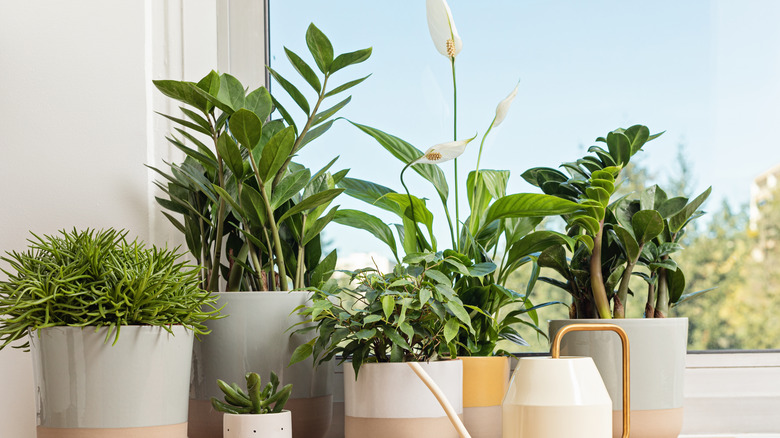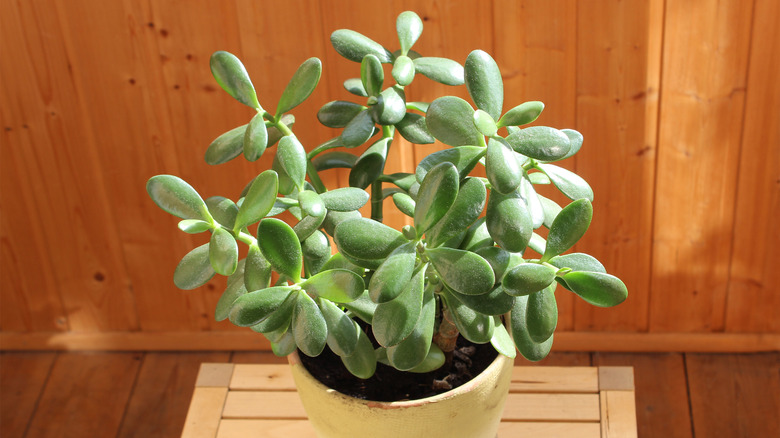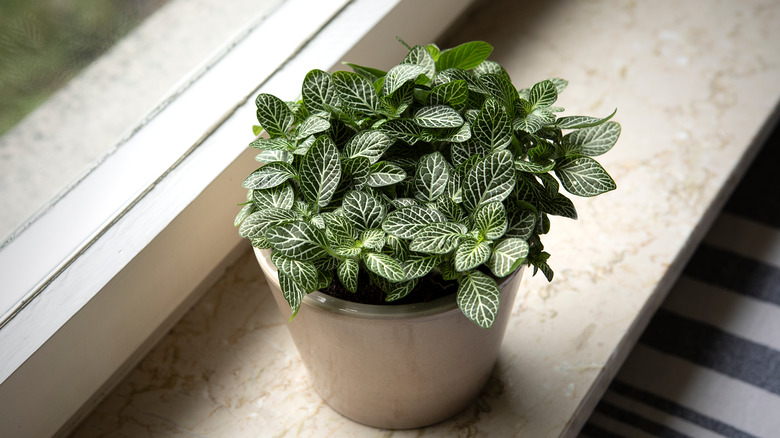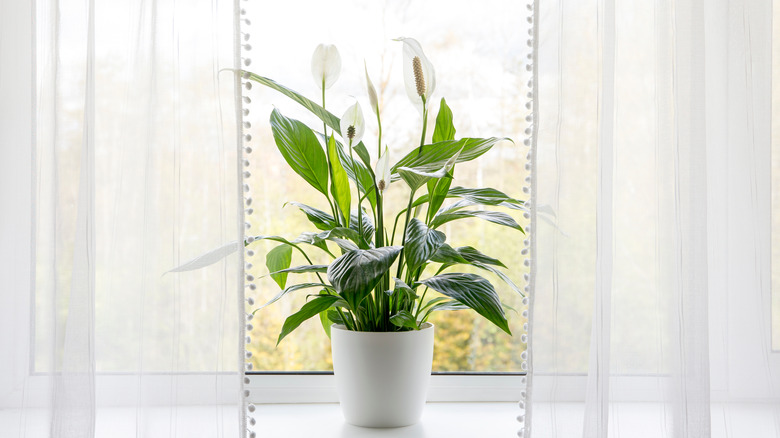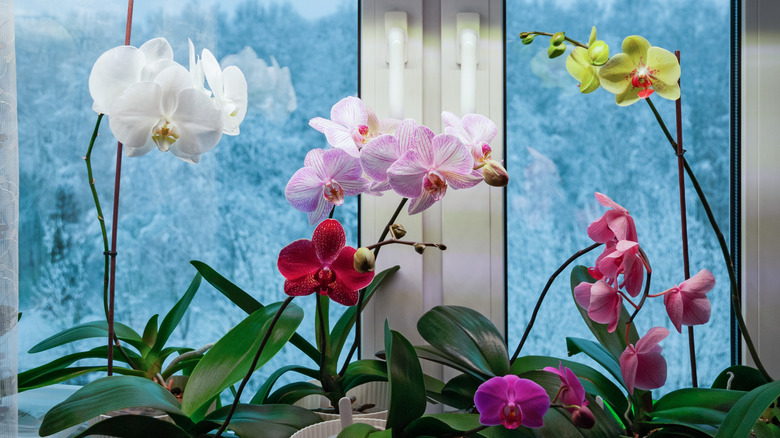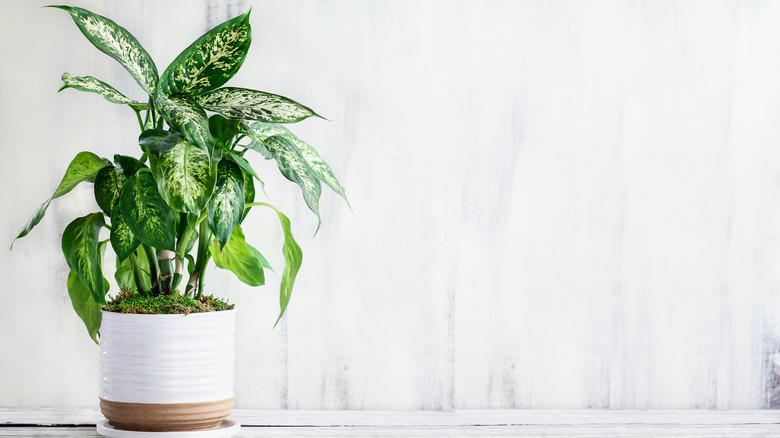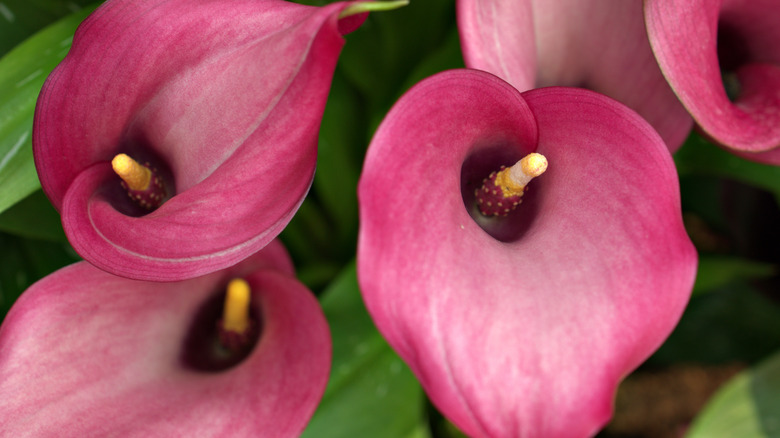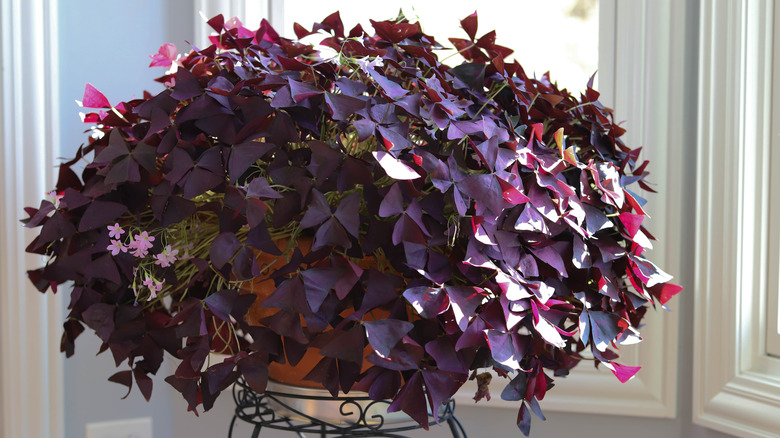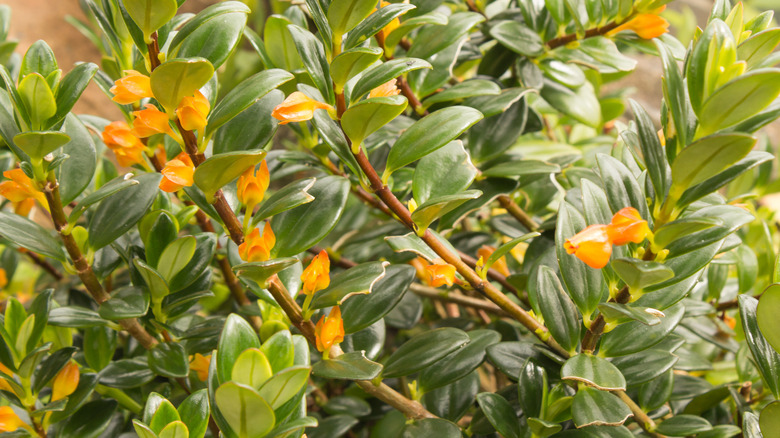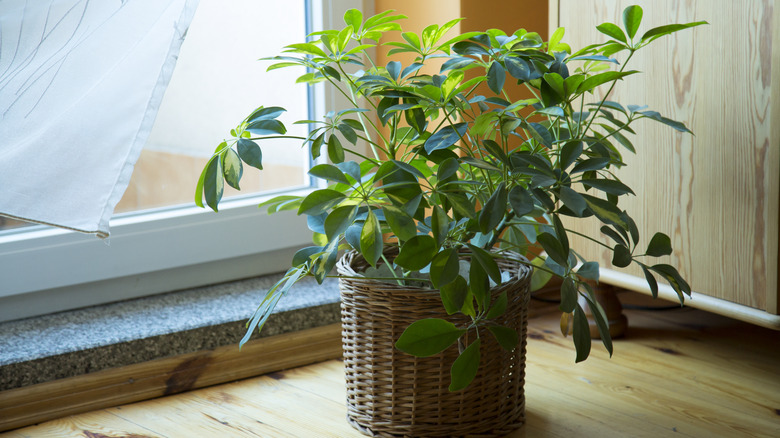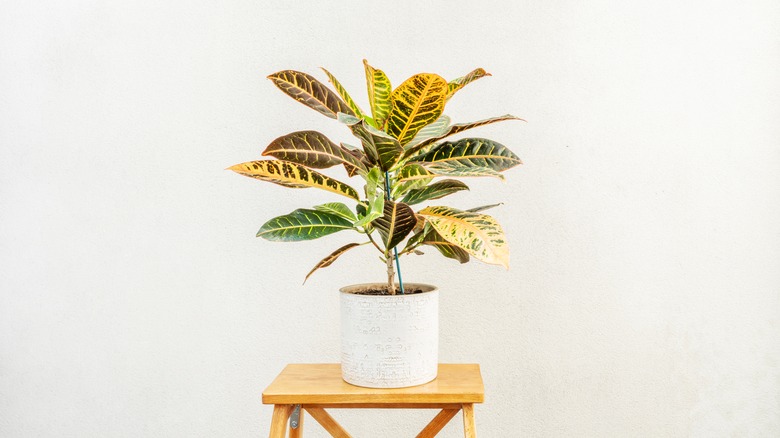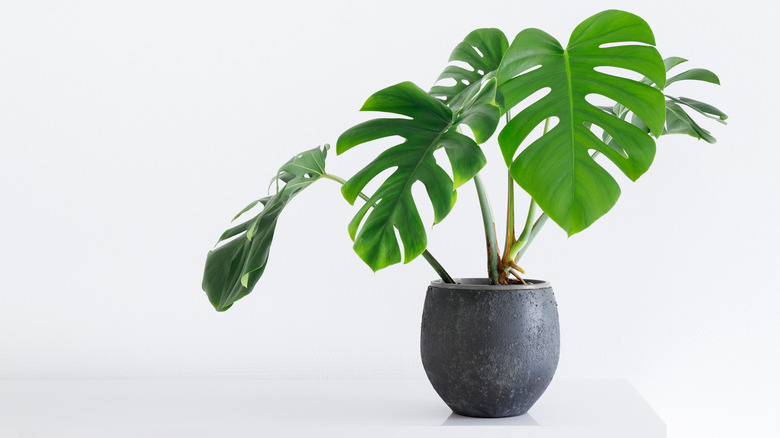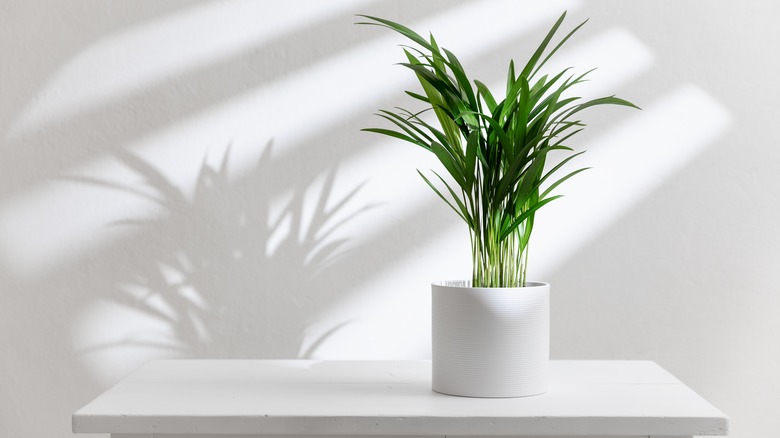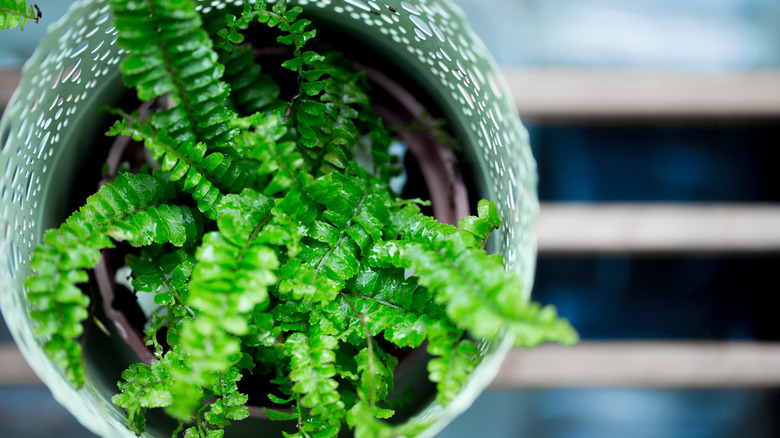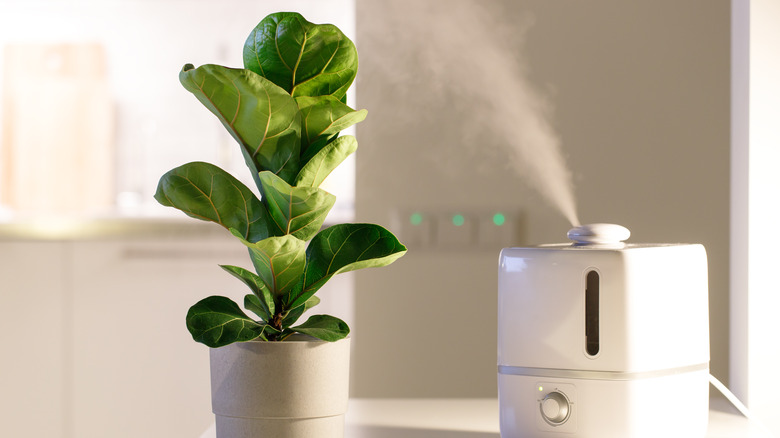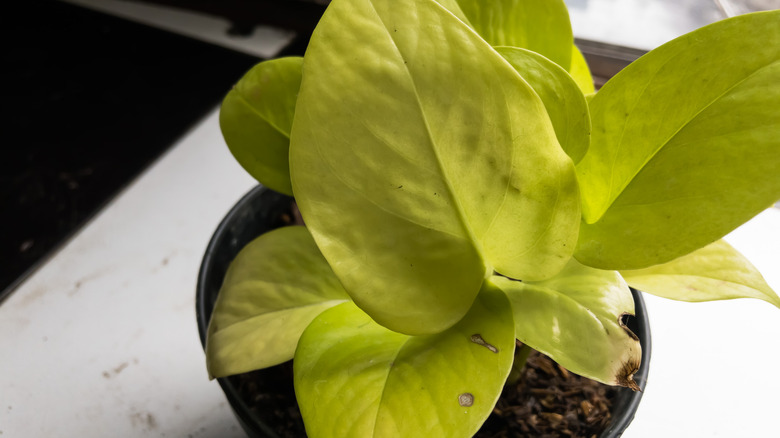15 Plants Perfect For An East-Facing Window
Unique plants that can only survive in warm, humid climates typically make great houseplants in the colder regions of the United States. For many tropical plants, such as umbrella trees, orchids, and goldfish plants, east-facing windows provide the best source of light that mimics their native environment. In general, these tropical species typically grow in the forest, where they receive filtered light, temperatures above 55 degrees Fahrenheit, and lots of humidity. These are the conditions you'll want to replicate for your plants at home, as per Pennington.
With east-facing windows, you can turn one or more of your rooms into a foliage-filled oasis. Here, we will tell you about some of the best plants to keep on your windowsill, in a hanging planter, or on a nearby shelf. But, before you get ahead of yourself, be sure to know the growing requirements for your favorite species before you buy. This way, you can raise them right the first time.
1. Jade plant
The jade plant (Crassula argentea) is one of those houseplants that most home gardeners can't live without. This extremely popular succulent plant is low-maintenance and drought-tolerant, and it can handle several different types of lighting, as explained by the University of Florida Extension. When kept in an east-facing window, your jade plant will live for many years and blossom if you're lucky.
Bloom Season: Spring
USDA Growing Zone: 10 to 11
Growing Conditions: Bright, medium, or low indirect light
Soil Type: Well-draining potting mix
Size: 2 to 4 feet tall and 1 to 3 feet wide
2. Nerve plant
Nerve plants (Fittonia albivenis) are commonly grown indoors in colder climates. However, because they love warm weather and some sunlight, these herbaceous perennials enjoy an indirectly sunny window. Here, they will stay warm but not be burned by harsh sunshine, as per Missouri Botanical Garden.
Bloom Season: Summer
USDA Growing Zone: 11 to 12
Growing Conditions: Bright indirect light
Soil Type: Peaty or soil-based potting medium
Size: 6 inches tall and 1 foot wide
3. Peace lily
Peace lilies (Spathiphyllum spp.) can be identified by their glossy, oval leaves and their unique white flowers. As noted by Clemson Cooperative Extension, these plants have great air-purifying abilities, which make them wonderful houseplants. Though peace lilies are tolerant of most growing conditions, it's best to keep them in an indirectly sunny spot with well-draining soil that is watered regularly.
Bloom Season: Spring
USDA Growing Zone: 10 to 11
Growing Conditions: Bright indirect light
Soil Type: Well-draining potting mix
Size: 1 to 6 feet tall
4. Moth orchid
Moth orchids (Phalaenopsis spp.) are frequently grown as houseplants because they need specific conditions to bloom. According to the University of Maryland Extension, these orchids enjoy chipped bark instead of soil, plenty of humidity, and bright indirect light from an east-facing window.
Bloom Season: Winter to spring
USDA Growing Zone: 11 to 12
Growing Conditions: Bright indirect light
Soil Type: Loose bark or another loose potting medium
Size: 3 feet tall maximum
5. Dumb cane
Dumb cane (Dieffenbachia spp.) is a tall growing plant with lots of tropical-looking leaves, as described by Miracle-Gro. Most people choose to grow their dumb cane inside because few are lucky enough to live in the right region to grow them outdoors. Still, it makes for a great houseplant that brightens up any room.
Bloom Season: Rarely flowers
USDA Growing Zone: 11 to 12
Growing Conditions: Bright indirect light
Soil Type: Lightweight potting mix
Size: Up to 6 feet tall and 3 feet wide
6. Calla lily
Calla lilies (Zantedeschia rehmannii) are grown from bulbs similar to tulips or daffodils. They develop quickly and flower throughout the spring. You can choose from several colors of calla lilies, including yellow, rose, white, orange, or maroon, as Longfield Gardens notes.
Bloom Season: Early to late spring
USDA Growing Zone: 8 to 10
Growing Conditions: Bright to medium light
Soil Type: Well-draining, organic potting mix
Size: 1 to 2 feet tall
7. False shamrock
The false shamrock plant (Oxalis triangularis) will remind you of the weedy three-leaf clover species that you may find in a patch of grass. However, this plant is much larger and forms a clump of green or purple foliage littered with small white flowers in the summer, says Gardenia. False shamrock is considered invasive in some areas, so keeping it indoors in an east-facing window is better than planting it outdoors.
Bloom Season: Summer
USDA Growing Zone: 8 to 11
Growing Conditions: Bright indirect light
Soil Type: Well-draining potting mix
Size: 1 foot tall and 2 feet wide
8. Goldfish plant
The goldfish plant (Nematanthus gregarius) is named for its orange and yellow tubular flowers that are shaped like small goldfish. Also called the clog plant, this trailing subshrub is characterized by plump green leaves and clusters of blossoms in the summer, as mentioned by RHS.
Bloom Season: Summer
USDA Growing Zone: 10 to 11
Growing Conditions: Bright indirect light
Soil Type: Well-draining, organic potting mix
Size: 20 inches tall and 40 inches wide
9. Umbrella tree
The umbrella tree (Schefflera arboricola) is a Taiwanese evergreen shrub that is grown as a houseplant in the United States. It requires some maintenance, such as pruning, but it won't need frequent watering, as explained by North Carolina State Extension. Still, keep in mind that this small tree contains toxic calcium oxalate crystals in its leaves, so you must keep it far out of reach from children and pets.
Bloom Season: Summer
USDA Growing Zone: 10 to 12
Growing Conditions: Bright indirect light
Soil Type: Well-draining potting soil
Size: 6 feet tall and 3 feet wide
10. Croton plant
Croton plants (Codiaeum variegatum) are a household favorite among many novice and expert houseplant gardeners. The species' bright foliage adds color and excitement to a home filled with greenery. However, for the best leaf color, owners of croton plants should provide them with high humidity, bright indirect light, and regular watering, as taught by Missouri Botanical Garden.
Bloom Season: Year-round
USDA Growing Zone: 11 to 12
Growing Conditions: Bright indirect light
Soil Type: Well-draining potting mix
Size: 2 to 6 feet tall and wide
11. Swiss cheese plant
The monstera plant (Monstera deliciosa), which is also known as the swiss cheese plant, is a climbing vine, as per the University of Connecticut. However, when kept indoors, the vines are grown as a cluster to make the plant look like a shrub. You will recognize the swiss cheese plant from its giant leaves with many holes that give it its common name.
Bloom Season: Rarely flowers indoors
USDA Growing Zone: 10 to 12
Growing Conditions: Bright to medium indirect light
Soil Type: Well-draining, organic potting mix
Size: Up to 15 feet tall indoors
12. Areca palm
Areca palms (Dypsis lutescens) grow quite tall in nature, but when kept as houseplants, they tend to stay only a few feet tall. The areca palm leaves are fan-like and require high humidity to stay green and waxy. In the summer, this palm may produce yellow flowers that give way to yellow-orange fruits, though this is unlikely to occur indoors, explains North Carolina State Extension.
Bloom Season: Summer
USDA Growing Zone: 10 to 11
Growing Conditions: Bright indirect light
Soil Type: Well-draining potting mix
Size: Up to 10 feet tall
13. Boston fern
The Boston fern (Nephrolepis exaltata 'Bostoniensis') is chosen again and again for its broad evergreen fronds that grow up to 4 feet long, according to the University of Wisconsin-Madison. The plant grows well in a container and looks even better in a hanging planter. Depending on your USDA zone, you can hang it outside during the summer in a sunny location.
Bloom Season: Does not flower
USDA Growing Zone: 9 to 11
Growing Conditions: Bright indirect light
Soil Type: Well-draining potting soil
Size: Up to 7 feet tall
14. Fiddle leaf fig
Fiddle leaf figs (Ficus lyrata) are grown as houseplants in a sunny window in most regions of the United States. These trees, which grow between 2 and 10 feet tall indoors, are well-known for their large, glossy leaves that resemble fiddles, as explained by Missouri Botanical Garden.
Bloom Season: Rarely flowers indoors
USDA Growing Zone: 10 to 12
Growing Conditions: Medium indirect light
Soil Type: Soil-based potting mix
Size: 2 to 10 feet indoors
15. Heartleaf philodendron
The heartleaf philodendron (Philodendron hederaceum), also called parlor ivy, is a climbing vine that features heart-shaped leaves on slender stems, describes North Carolina State Extension. Plant owners commonly grow their philodendron in a container placed on a shelf where the cascading stems can fall toward the floor.
Bloom Season: Spring and summer
USDA Growing Zone: 10 to 11
Growing Conditions: Bright indirect light
Soil Type: Well-draining potting mix
Size: 4 inches to 6 feet long

